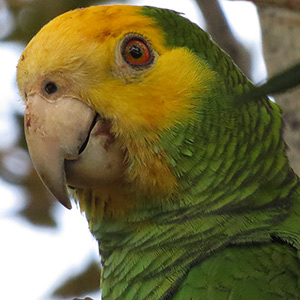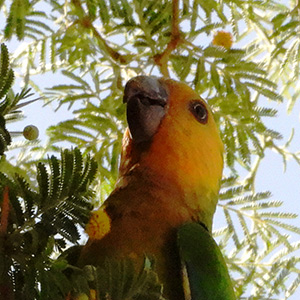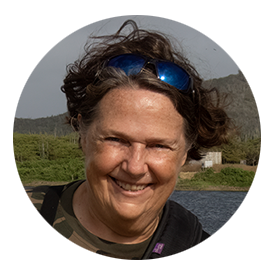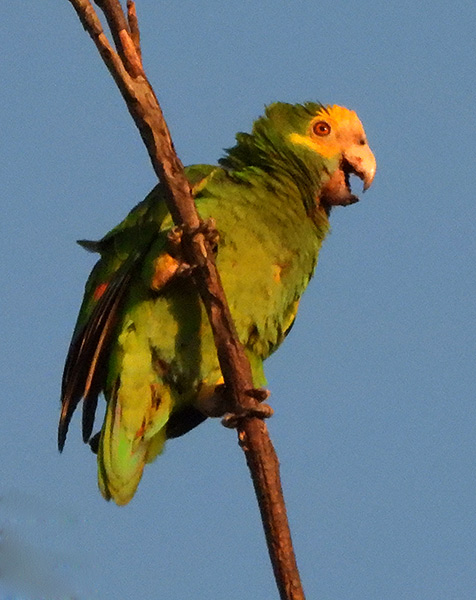Parrot? Or Parakeet?
That is the Question!
This primer on Bonaire’s parrot and parakeet will help you distinguish between the two species.
Posted August 15, 2019
How to distinguish between Bonaire’s parrot (Yellow-shouldered Parrot) and its parakeet (Brown-throated Parakeet).
Many visitors to Bonaire see a flash of green in their gardens or on the road while driving and assume they have successfully observed the Lora, as Bonaire’s Yellow-shouldered Amazon Parrot is locally called. And perhaps that sighting is correct, but perhaps it is not! Bonaire’s parakeet, the Brown-throated Parakeet, will also provide that “flash of green.” So which bird did you see?
Distinctive differences in outward appearance between the Yellow-shouldered Parrot and the Brown-throated Parakeet.
If you have the opportunity to study the bird before it has flown away, there are five distinct visual differences that you can readily observe:
- the throat coloration,
- the color of the bill,
- the facial coloration,
- the length of the tail,
- and the thickness of the body.
Look at the face first.
The faces of the birds will give three clues as to which species you are observing. The parakeet will have a tannish-brown feathering at the throat, thus its name: The Brown-throated Parakeet. The parrot does not have this coloration at its throat and instead, its green feathers go all the way up to its cheek.
Your second clue on the face will be the primary color. Although both heads might look yellow, the faces on the parakeet take on a more orangish cast, while the parrot’s face is yellow.
Your third clue on the face is the color of the bill. The Yellow-shouldered Parrot will have a light-colored bill, while the Brown-throated Parakeet will have a darker bill.
Next, look at the tails and bodies.
The parrot’s tail is significantly shorter than that of the parakeet. This is especially helpful when identifying the birds in flight.
Also, look at the body itself. The Yellow-shouldered Parrot has a thicker body than that of the Brown-throated Parakeet, which presents a slimmer, more elongated body.
Vocalizations are similar, but the calls of the Yellow-shouldered Parrot and the Brown-throated Parakeet can be distinguished.
Although the vocalizations of the parrots and parakeets are similar, with a little bit of practice, one can distinguish between the two birds.
Yellow-Shouldered Parrot Vocalization.
The Yellow-shouldered Parrot’s call is lower in pitch and can be described as “raucous.”
Brown-throated Parakeet Vocalization.
The Brown-throated Parakeet’s call is a higher pitch and can be described as “chatty.”
Where you observe the bird might provide a clue as to which species it is.
The range of the parrot is normally limited to the environs of Kralendijk through the north of Bonaire. There are major roost areas in Hato, Washington-Slagbaai National Park, and at Fontein. During periods of drought, the parrots do tend to be seen farther to the south, as far as the airport or the neighborhood of Nikiboko, as they need to forage farther from the roosts when food is more scarce.
The parakeet has a larger, more extended range on Bonaire. It can be found in nearly any location, except around Pekelmeer in the south of Bonaire. It is commonly observed in nearly all neighborhood gardens, around Lac Bay, and to the north of Bonaire, including Washington-Slagbaai National Park.
Quick Facts and Current Status of the Yellow-shouldered Parrot and the Brown-throated Parakeet.

Yellow-shouldered Parrot
(Amazona barbadensis)
Diet: Feeds upon fruits, seeds, and cactus flowers
Breeding: Lays 3 or 4 eggs
Status: Vulnerable

Brown-throated Parakeet
(Eupsittula pertinax)
Diet: Feeds upon fruits, seeds, and cactus flowers
Breeding: Lays 3 to 6 eggs
Status: Least Concern
About the author
Susan has been living on Bonaire for over 30 years. She is a certified bird guide, a PADI SCUBA Diving Master Instructor, and an underwater and topside photographer.

Reach out to Susan
Contact Susan via email, Facebook Messenger, give Susan a call, or simply use the online form below.
If you have any questions in regard to your birding tour on Bonaire, feel free to contact Susan to get answers. She is always happy to elaborate on routes or best times for a tour based upon your own personal preferences. Tours can be tailored to your own interests, whether that be birds, photography, or both!
It is also recommended that you do some homework about Bonaire's birds before you visit. By knowing a little bit about the birds which might be encountered on tour, your enjoyment will be heightened! Be sure to check out these resources for Bonaire Birding. Reading the Bonaire Bird Blog will also accustom you to the birds that habitually are encountered on Bonaire.
Facebook Messenger
Get in touch via Facebook Messenger
Telephone
Get In Touch
Get in touch with Susan to check availability for the dates you are visiting Bonaire.


